#1 The four main components of a solar power system
Solar power systems comprise four main parts:
- solar panels
- inverter
- racking
- monitoring
Let’s go into more detail for each:
Component #1: Solar panels
Solar panels are simply a collection of 60 or more solar cells. Panels can use different cell types and different cell arrangements.
For cell type – you can buy either monocrystalline or polycrystalline:
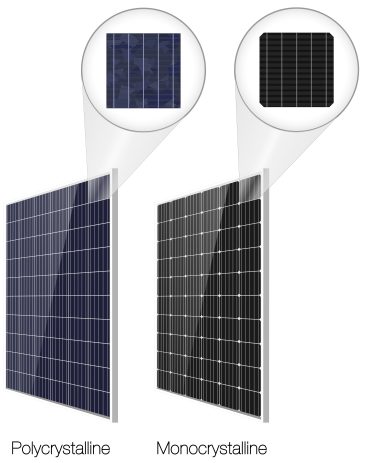
The difference in performance between a mono and poly panel of a similar wattage is absolutely marginal – so don’t feel like you have to install one over the other.
For cell arrangement – you can choose
- ‘standard’, which look like the mono/poly panels above
- ‘half-cut’, which doesn’t mean on the beers – it means they are cut in half
- or ‘shingled’, where the cells are slightly overlapping
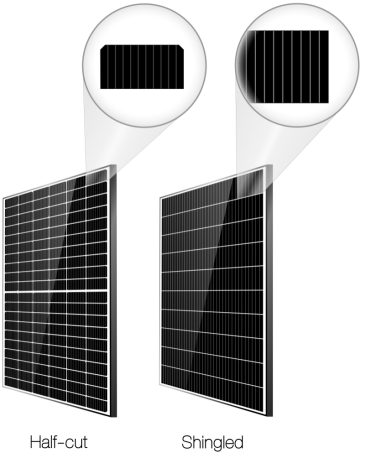
Pro-tip: There are some benefits to using half-cut or shingled panels over conventional ones if you have shade that creeps up on the solar panels through the day. Otherwise, don’t stress – any cell arrangement will work well.
Solar Panel Dimensions
Panel manufacturers generally make solar panels in two physical sizes – 60 cell “residential size”, which is approx. 1m x 1.65m, and 72 cell “commercial size”, which are approx 1m x 2m.
“Commercial size” 72 cell panels are bigger and heavier and pump out more watts than residential-sized 60 cell panels.
Some companies will quote households ‘commercial sized’ panels to squeeze more power out of fewer panels on the roof. But that makes it much harder to get the ‘clamping zones’ right. And if the solar panel clamps are not in the correct place, you compromise the panels’ longevity because they can flex too much.
Pro Tip: Don’t install ‘commercial-sized’ panels on small residential roofs as you are asking for trouble.
Pro Tip: Goofy clamping zones are a common problem with cheap installs.
It doesn’t really matter if you get mono, poly, regular, half-cut or shingled panels. What matters most is that you get a good brand that is well supported in Australia.
Solar Panel Brands
Now, you probably don’t know a good solar panel brand from a lemon. And why should you?
So, here’s a handy chart of all the brands I consider to be good quality and well supported in Australia:
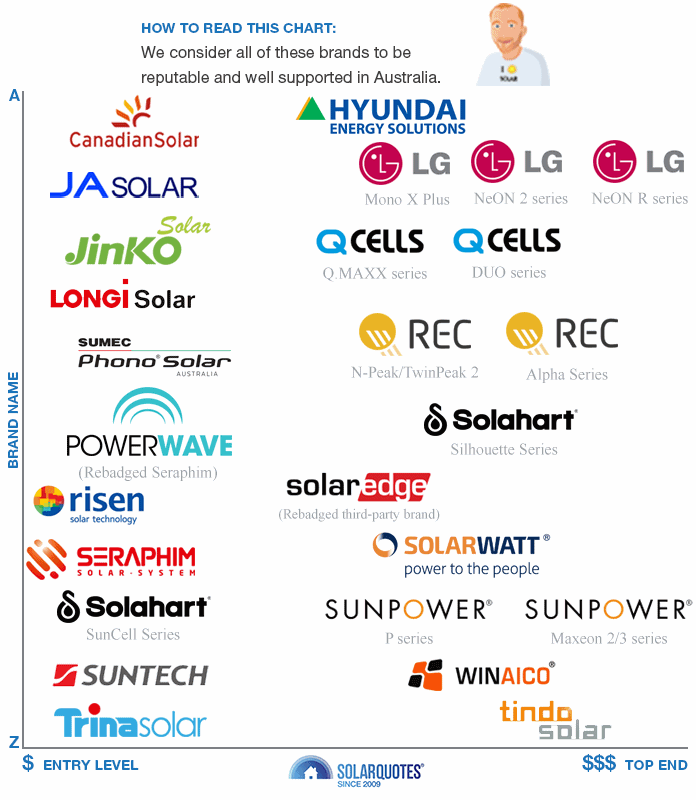
If you want to play it safe, stick to the brands on this chart! See the criteria we developed for the chart here. Note: SolarQuotes does not take incentives from manufacturers to promote or give their solar panel brand preference.
This list is not exhaustive – and if you’re not sure about a brand, shoot me an email – but this chart represents probably 95% of brands being quoted in 2021 in Australia and are manufacturers I consider a safe bet.
Pro Tip: Find detailed reviews of each brand here: Q-Cells | Risen | LG | Trina | Jinko | Phono | Sunpower | Seraphim | Canadian Solar | Suntech | REC | JA Solar | Tindo | Longi | Winaico | SolarWatt.
I could list all the brands I believe to be crap, but my lawyers are busy enough. So, unless you are an industry expert I’d just strongly advise sticking to installing brands on the chart.
To get an idea of how buying premium panels will affect your budget; going for a high-end brand such as LG over a budget-end brand like Longi can add about 30% to the total system cost.
The difference in *performance* between a budget brand such as Jinko and a premium brand like Sunpower is fairly marginal. The main difference between the two is:
- how much their energy output will degrade over the years.
- the length of their product warranty.
For example, 370W Jinko solar panels are warranted to have 83.1% of their rated output after 25 years and have a 12-year product warranty.
Top-end 400W Sunpower Maxeon panels are warranted to have 92% of their rated output after 25 years and have a full 25-year product warranty.
But – the Sunpower Maxeon costs more than double that of a Jinko panel. Is that slower performance degradation and longer product warranty worth it? That’s a decision for you to make.
Component #2: Solar Inverter
The second main component of a solar power system installation is the inverter, which can be either a string inverter (around the size of a briefcase) or microinverters, which are approximately the size of a paperback book.
Microinverters cost more than string inverters, but bring a number of benefits
A string inverter is installed on a wall, and all the solar panels connect to it. A microinverter is installed on the back of, or beside each solar panel.
There’s also a third option – ‘power optimizers’. These are a hybrid between the two because an optimiser system has both a string inverter on the wall *and* optimisers on each panel’s back.
You can read about the pros and cons of each inverter choice in a detailed article here.
Pro-tip: Never mount a string inverter where it will be in full sun. Choose a shaded spot, a cool garage, or ask the installer to build a simple shade over the inverter. Direct intense sunlight kills inverters because it cooks them – and Australia’s sun is particularly harsh.
The inverter’s job is to convert the steady DC electricity solar panels produce into oscillating 230 volts AC electricity, which is what everything in your home uses.
The inverter is the component most likely to fail in a solar power system in the first 10 to 15 years. This is because they work really hard all day and they do wear out.
So even if you’re on a limited budget, I’d recommend considering a mid-range or high-end inverter as I’m confident they’ll last longer overall than the cheapest ones.
And if your inverter fails – that will bring down your whole system (unless you’re using micro-inverters).
Solar Inverter Brands
Here’s a rundown of the inverter brands available in Australia I believe to be good quality and well-supported.
Again, this list is not exhaustive, but any reputable installer has a 95% chance of quoting you one of these brands:
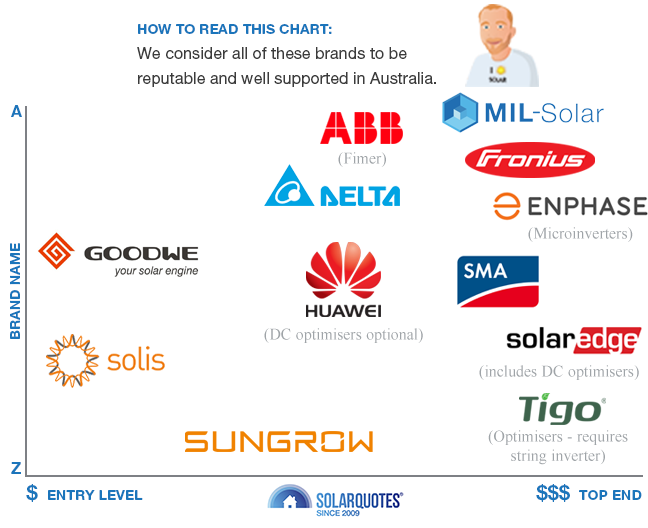
These are all inverter brands I’d be happy to install on my own house. You can view the criteria we developed for the chart here. Note: SolarQuotes does not take incentives from manufacturers to promote or give their solar inverter brand preference.
Pro Tip: Find reviews of each brand here: ABB | SMA | Fronius | Goodwe | SolarEdge | Delta |Huawei | Sungrow | Enphase | Solis.
Upgrading from a budget inverter like Goodwe to a premium inverter such as Fronius will add around $1000 to a residential solar system installation (a bit more if your system is over 10kW). Going for optimisers or micro-inverters can add an extra couple of thousand on top of that.
Component #3: Solar Panel Racking
Your solar panels are mounted on a racking system that connects them securely to your roof.
There is a wide variety of racking brands out there – and at the end of the day, racking is just aluminium bolted together.
So, most brands are much of a muchness, except for premium brands such as Radiant that provide more adjustability and flexibility in the system’s design and may corrode less over decades.
The chart below shows brands we’re familiar with, and where they sit in a spectrum of price. Note that the difference in price between a budget end brand and a premium end brand is around $100 per kilowatt of solar panels installed:
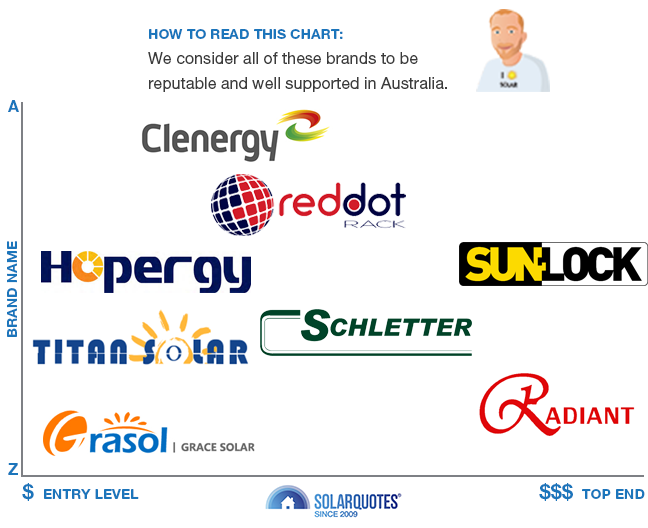
The main difference between racking brands is how easy they are for installers to work with, especially with difficult roofs. Note: SolarQuotes does not take incentives from manufacturers to promote or give preference to their racking brand.
Component #4: Consumption Monitor
Consumption monitors are small devices that sit in your switchboard and measure how much electricity is coming from or going to the grid.
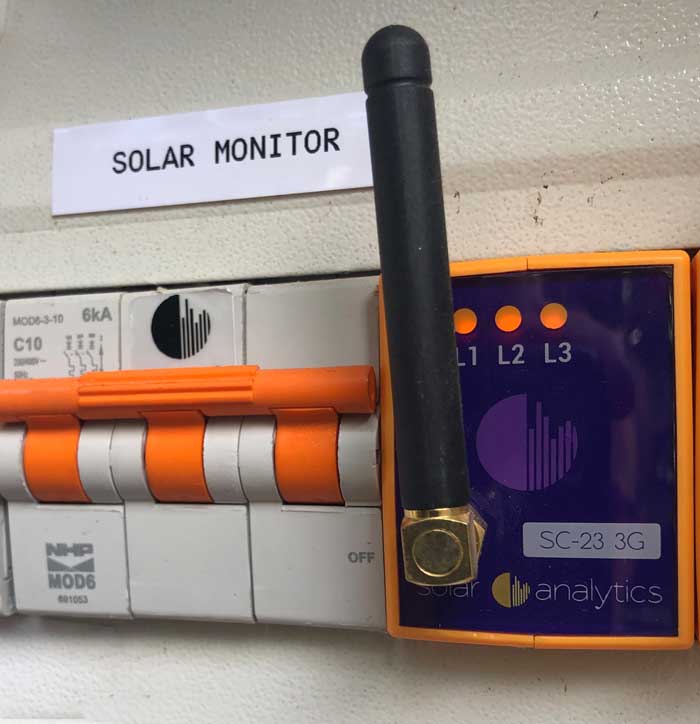
A consumption monitor in my switchboard.
To be clear – you can install a solar system without a consumption monitor, but I strongly recommend getting one.
Without a consumption monitor, your inverter will only be able to tell you how much solar energy your system is producing at any point in time. You’ll only see the solar generation curve on your inverter’s monitoring app:
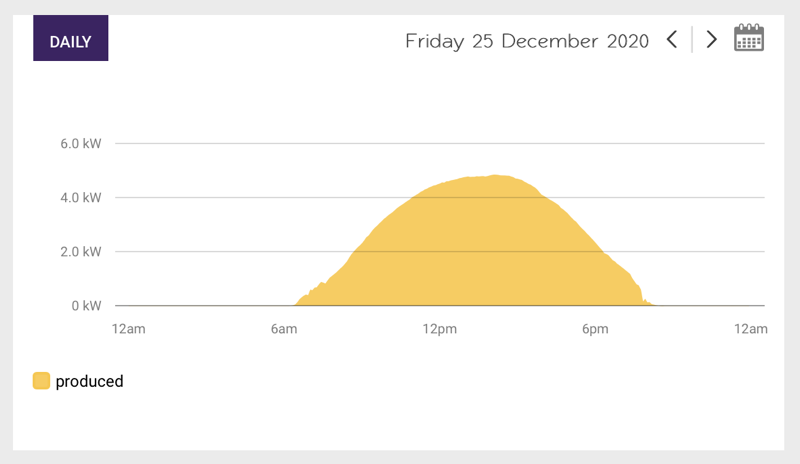
But you’ll be blind as to how much energy your home is using – and when.
If you invest in the consumption monitor hardware, your monitoring app will be much more useful and will look like this:
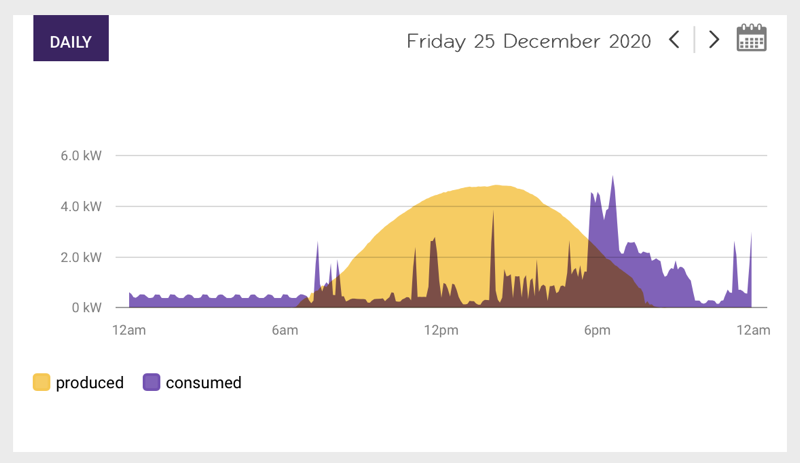
The purple area is the energy used by your home.
I could go into a lot more detail about why having this extra information is important, but for now, I’ll just say that for around $500, the installation of a consumption monitor will allow you to understand exactly how your solar system is working and is the best way for you to manage your energy use for maximum savings.
For me personally, it’s worth every dollar.
#2 Understanding how your home uses solar energy
Your solar system will only ever operate in one of 2 modes:
Mode #1 Your system is generating more solar power than your home needs.
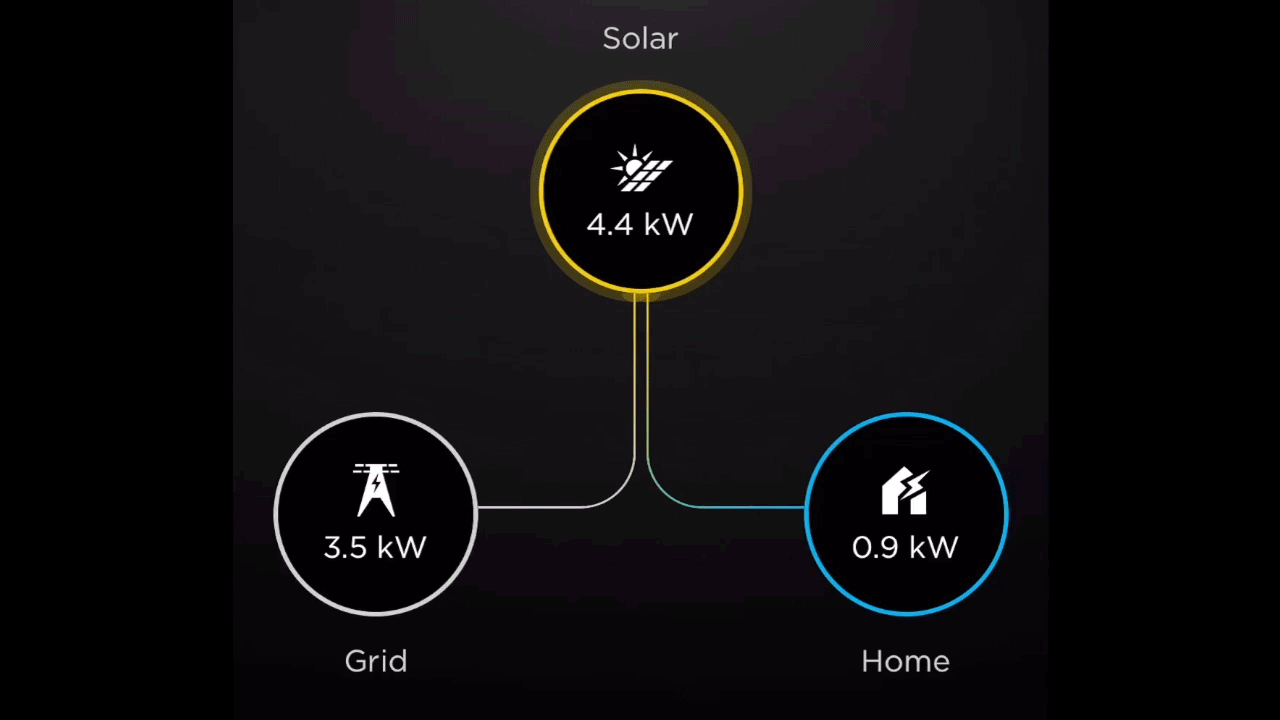
Credit: Tesla App
Here, my solar power system is producing 4.4 kW.
0.9 kW is going into my home, with the surplus 3.5 kW simply going into the grid.
My retailer pays me a ‘feed-in tariff’ for each kWh of solar energy that I export. Here in SA at the time of writing, I’m getting 14 cents per kWh of energy exported.
Mode #2: Your home is using more power than your solar system is generating
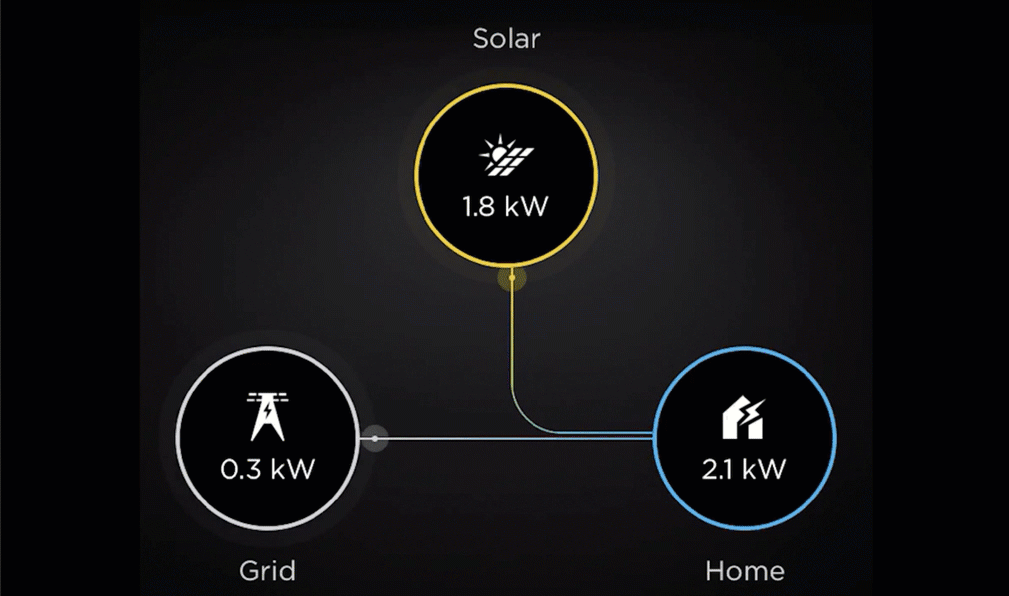
My home solar power system importing grid electricity because I’m not generating enough solar at this point in time.
Here my home needs 2.1 kW of power, but my solar power system installation is only generating 1.8 kW. The grid simply tops up my home with the extra 0.3kW required. Obviously, you have to pay for any imported energy.
In Adelaide, I pay 36 cents for grid electricity and get 14 cents for exported solar energy. This means self-consumed solar is more than twice as valuable as exported solar electricity.
This is why I have my appliances set to run when the sun is out and don’t feel guilty when I switch on my aircon to pre-heat or pre-cool my house during the day, for a comfortable temperature at night.
#3 How many solar panels should you buy?
My answer to this question has changed considerably compared to just a few years ago.
This is because solar installation prices have fallen considerably and electricity prices have risen.
The only limitations now are your budget, what your roof can properly fit, and the amount your local electricity network (DNSP – Distributed Network Service Provider) allows you to install.
For most homes, the minimum you should consider is buying 6.6 kW of panels (approx. 18 in total) with a 5 kW inverter.
Pro Tip: You can, and should, install up to 33% more panels than the inverter is rated at. For example, if you install 6.6kW of panels with a 5kW inverter, you’ll get 33% more solar rebate and lots more power in winter, mornings and evenings. It’s a very efficient use of the inverter. Also, in many areas, the smaller the inverter, the easier it is to get permission to connect to the mains electricity grid.
If you use a lot of electricity or you’re likely to add an electric car and/or battery to your home in the next few years, you should consider going larger than a 6.6 kW installation.
I don’t think I’ve ever heard someone complain that they put too many solar panels on. But people do regret putting too few panels on – because it’s expensive and complicated to add panels to an existing system at a later date.
I’ve written about this topic in more detail here.
#4 The solar rebate: still very much alive and kicking – and generous.
The famous Australian federal solar rebate, technically known as the STC scheme, acts as a point of sale discount off a solar installation’s final cost.
All the prices you see advertised will already include this discount. It’s worth about $500 per kilowatt of solar panels installed, but this will vary slightly depending on where you live.
So, for example, 6.6 kW of panels attracts around $3,300 in rebates.
Anyone can claim the rebate, even if you’ve already bought solar power systems in the past and want to buy a new system.
The only restrictions on claiming the rebate are:
- Your system installation must be less than 100 kW in size (which is bloody big!).
- You get it installed and designed by a Clean Energy Council (CEC) accredited professional (you can ask the installer on the day to provide proof of accreditation!)
- You use panels and solar inverters approved for installation in Australia by the Clean Energy Council (such as those I mentioned in my chart above).
The federal solar rebate is slowly being phased out. It reduces by one-ninth of today’s value every January until it goes to zero in 2031.
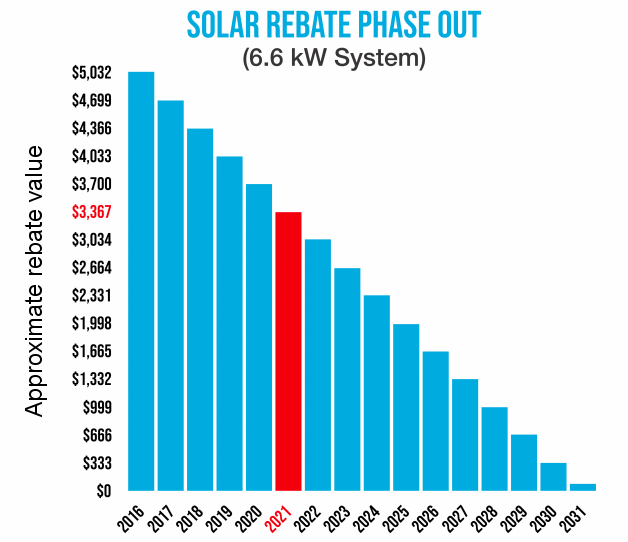
Approximate solar rebate for 6.6kW of panels ($37 STCs, Zone 3).
For Victorians, the Labor government introduced a state-level rebate that offers eligible recipients (up to) an extra $1,850 off the cost of a solar system at the time of writing.
Pro Tip: The ‘federal rebate’ is based on the number of solar panels, not the inverter’s size. This often makes adding panels over and above the inverter rating very worthwhile.
#5 Don’t get the ‘rebate’ and the ‘feed-in tariff’ confused
We’ve already learned the ‘feed-in tariff’ is the rate you are paid for solar electricity you export into the grid.
Between 2009 and 2012, people signed up to generous feed-in tariffs that paid them anywhere between 20 cents and 66 cents for every kWh of electricity exported. These generous tariffs were designed to kick-start the solar energy industry when solar power systems were much more expensive.
Solar energy systems have reduced in price more than 85% in Australia since 2008, and the feed-in tariffs have reduced to between 3 and 20 cents, depending on your retailer.
This reduction is why you see so many people screaming ‘Solar power isn’t worth it anymore! The rebate has been massively reduced!’
They’re actually confusing the rebate with the feed-in tariff. As mentioned, the ‘federal rebate’ is still alive and kicking. It is being gradually phased out but isn’t being reduced significantly anytime soon.
We’ve run the numbers, and even with these lower feed-in tariffs, it’s not difficult to get a 5-year payback on your solar energy system.
Pro Tip: When you get a solar power system, use the timers on your washing machine and dishwasher so they run during the day. Also, put timers on your hot water and any pool pumps, and you can shift significant amounts of energy use to the daytime, increasing the returns on a solar system installation.
#6 The basics of roof direction/angle for optimal solar electricity generation.
Panel Direction
First – the absolute basics. The sun rises in the east, and sets in the west.
This means:
- East-facing panels will generate more power in the morning.
- West-facing panels will generate more in the late afternoon.
- North-facing solar panels will generate the most energy overall, but less in the morning and late afternoon compared to east and west-facing panels respectively.
East and west-facing panels will produce about 15% less energy per year compared to north facing.
But – a working household can self-consume more solar energy with east and west-facing panels, because they produce more energy before and after school/work, accelerating their system’s payback compared to a north-facing one.
Sadly, I’ve spoken to more than one homeowner with a massive east or west roof ripe for harvesting solar energy who thinks it just isn’t worth it if their panels can’t face north.
It used to be true if you couldn’t install panels on a north-facing roof, then a solar power system wasn’t worth it.
Now that prices of solar power systems have dropped so much, you can get a fantastic return on investment from east or west-facing panels, or a combination of north, east and west.
Hell, despite what many well-meaning installers may claim, you can even get a good return with south-facing solar panels!
I am about to install panels on my south-facing roof because I have a battery and two electric cars, and need as much generation as possible to recharge them.
Panel Angle
The ideal panel angle to maximize the energy produced over the whole year is simply within a few degrees of the latitude of your location:
| Canberra | Hobart | Darwin | Adelaide | Perth | Brisbane | Melbourne | Sydney |
| 35° | 42° | 12° | 35° | 31° | 27° | 37° | 34° |
So, for my house in Adelaide, the ideal solar panel angle is around 35° from horizontal.
If you’re not able to install your panels at the ideal angle, don’t worry too much. The solar panels in my own installation are at 15 degrees, and I only lose 4% in annual energy yield compared to the perfect angle.
Generally and unless your roof is flat, the ideal angle is whatever your roof is built at.
If your roof is flat, you can still install the panels flat – but you need to be aware that you’ll lose about 10% of your total annual generation, and you’ll need to pay someone to clean them frequently (around 3-4 times a year), as you need at least 10 degrees tilt for rain to reliably run off the panels and clean them.
I recommend using tilt frames for a flat roof to avoid the lost generation and hassle of cleaning them.
Beginners Note: The best angle to mount your solar panels is the angle that your roof has been built at. The exception is flat roofs. If you have a flat roof you must either mount them on tilt frames so they self-clean in the rain, or mount them flat and be prepared to get them cleaned multiple times per year.
#7 How solar system savings and payback are calculated
This depends on a few key things:
- The output of your solar power system (which, when annualised, is very consistent!)
- Your ‘self-consumption ratio’ – which is how much solar electricity you use in the home vs exports to the grid.
- Your feed-in tariff – which, as already mentioned, varies from retailer to retailer and state to state.
- Your usage tariff – which is what you pay for grid electricity.
Putting it all together – the main way a solar installation saves you money is by offsetting your grid electricity usage.
If you pay 36 cents per kWh – as I do in Adelaide – and your solar power system generates one kWh to offset that – you’ve just saved 36 cents.
But, if your solar system generates one kWh and sends that to the grid because it’s not needed– the value of that exported solar electricity is less.
Using my own plan as an example, I’m paid 14 cents as a feed-in tariff by my retailer, AGL.
14 cents is less than half of 36 cents (which is my usage tariff) – so self-consuming my solar power saves me more than twice as much as exporting it does.
Now, imagine being somewhere like Perth, where you can only get an average 4 cent feed-in tariff and pay 28c for grid electricity.
Meaning that, in Perth, self-consumed solar electricity is worth seven times as much as exported solar energy!
But – even in a crappy situation like Perth’s – a solar power system can still deliver a sub-5 year payback with only 20% self-consumption.
Here are some payback calculation examples for a 6.6 kW system taken from my solar calculator using typical prices and usage patterns:
- Sydney: 3 years
- Brisbane: 3 years, 2 months
- Canberra: 5 years, 3 months
- Perth: 4 years, 5 months
- Melbourne with VIC rebate: 2 years, 6 months
- Melbourne without VIC rebate: 3 years, 6 months
- Adelaide: 3 years
- Darwin: 6 years, 4 months
- Hobart: 6 years
Note: your circumstances will vary – make sure you do your own estimates if the payback is important to you.
About solar self-consumption
Australian households that use a lot of electricity during the day or can set their appliances to run on timers can have a self-consumption ratio of 50% or more and are a natural fit for solar panels.
Such households can see very short paybacks of between 2.5 to 5 years, a 20 to 25% return.
At home, I have 6 kW of solar and a battery, plus 2 electric cars. On my most recent winter bill, my self-consumption was a staggering 90%.
As the world becomes more and more electric, the amount of solar electricity used in a typical home will only increase.
But right now, If you are not at home during weekdays and don’t have an energy-guzzling pool or battery, your self-consumption will be lower. That may push the simple payback out to five to seven years, mainly depending on how high your feed-in tariff is.
But bear in mind, that’s typically a 12 to 15% return on investment – try getting that from the bank!
I’ll finish this section by saying – avoid any solar energy company that calculates your solar system savings based on 100% self-consumption.
Crazy high self-consumption, like my winter consumption, is still rare. Make sure you see the savings for more realistic scenarios such as 20% and 50% self-consumption.
#8 What price-range can you expect to pay for quality solar power, and why can quotes vary wildly in price?
As of January 2021, approximate prices for good quality solar panel systems in Australia (Tier 1 panels + quality string inverter), including full installation, are in the range of:
3kW: $3,500 – $5,000
5kW: $4,500 – $8,000
6.6kW: $5,000 – $9,000
10kW: $8,000 – $12,000
To be clear – the upper end prices are for top-end system installations (e.g. LG/Sunpower panels), installed by a solar energy ‘craftsman‘.
Note the above prices also include the discount from the solar ‘rebate’.
However, for those of you in Victoria, the above prices do not include the state-level rebate offered by the Victorian government (which provides a further rebate of up to $1,850).
If you want to downgrade to a reputable budget inverter (e.g. brands on the left-hand side of the inverter chart higher up this page), you may be able to save around $800 on these prices.
Costs can increase if you need a switchboard upgrade or other electrical work is required to make your home suitable for solar power, or if the design of your home makes the installation more difficult.
If you decide to install micro inverters or an optimiser-based system over a string inverter, costs will also increase by approximately 20%.
Installing battery storage (for an off-grid or hybrid system) will at least double the system’s price.
Pro Tip: Really cheap solar energy systems cost more in the long run, from repairs and lost output. I tell my friends to avoid these systems. It breaks my heart to see cheap solar panels go to landfill after a few years.
#9 Batteries – do you need them?
Batteries are great for energy security. The peace of mind from knowing that you will still have lights, refrigeration and other essential circuits no matter what happens to the grid can be priceless.
Batteries are also great fun. Seriously! There is something extraordinary about seeing your house run off nothing but battery power.
Batteries also provide a form of insurance against the risk of electricity prices going up and feed-in-tariffs going down.
A properly sized, correctly installed and configured battery can reduce your grid use by up to 95%, making you almost immune to electricity and feed-in tariff changes. To be clear – no-one knows which way electricity prices and feed-in-tariffs will go. However, if you have a battery you won’t care!
But these benefits come at a cost.
For example – without a battery rebate – it will cost around $10,000 to add a decent amount (around 10 kWh) of quality energy storage to a solar power system in Australia. Take 30-50% off these costs if you live in VIC, ACT or SA and are eligible for your state’s battery rebate.
The typical payback period of an unsubsidised battery of that size is at least 15 years. Most batteries have a 10-year warranty.
Compare this with a solar energy installation without batteries. A regular non-battery solar power system has a typical payback of around 3-6 years and will last about 25 years.
So – if you are buying batteries only to save money, unless you can access a state-based battery rebate, installing battery storage isn’t worth it for you. My advice is to wait 2-5 years for battery costs to come down before investing in energy storage.
Certainly don’t wait for batteries to come down in price before buying a solar power system, because that is locking in more years of high energy bills every quarter.
Pro-tip: You don’t need to buy a special type of system to be ready for batteries. Every grid connect system ever installed in Australia is compatible with future batteries using a technique called ‘AC coupling’.
But if you want a battery for energy security, insurance against changing electricity prices, and for the exciting technology, go for it. I’ve got one on my home, and I love it.
A note about state battery rebates: In South Australia, some postcodes in Victoria and ACT you can now get a battery subsidy which could halve the cost of a battery installation, potentially giving a sub-10-year payback.
A note about Virtual Power Plants (VPPs): A recent phenomenon is the ‘VPP’. In a nutshell, you can get a cheaper battery if you agree to let your electricity retailer control it.
They will then be able to charge and discharge your battery at will to profit from electricity price fluctuations. These VPPs are very new – so buyer beware! My personal take is if you want more control of your energy use, then don’t relinquish control to a big energy company.
Pro Tip: Counter-intuitively, some battery systems will not provide backup when the grid goes down. If you want backup, you must specify this upfront, as it requires careful design and some rewiring of your switchboard.
#10 How are you planning on paying for your system? Understanding finance.
Most Australians buy solar power systems with cash. If you are debt-free and have cash looking for a place to go, investing in a solar power system is worth serious consideration.
A solar system installation currently generates a tax-free, reliable return that is far higher than bank interest rates or government bonds at the time of writing.
However, some of us don’t have the luxury of easy access to thousands of dollars. Many solar installers offer “no interest” finance – and if that sounds too good to be true, it’s because it probably is.
Pro Tip: If you see a deal that claims ‘no interest’, your BS detector should be going off. All finance has a cost. The “no interest” deals often charge the installer a fee of around 15-25% on top of the ‘cash’ price. That extra cost is ultimately paid by you.
Now – don’t misunderstand me. Plenty of reputable solar installers, not just the ripoff merchants, offer “no interest” finance because many customers demand it.
But in my experience, you can get a much better deal overall by shopping around for a low-interest finance provider and avoiding the easy-sign-up, ‘no interest’ deals.
#11 Remote inverter shutdowns – scary sounding, but benign.
In South Australia, it’s been a requirement since October 2020 that your solar system can be ‘shut down’ remotely by the electricity network.
Why should non-South Australians reading this care? Because this will likely roll out nationally as the other states catch up with SA’s solar power capacity per capita.
This means the local network in SA, and soon networks across Australia will have a big red button that can shut down all recently installed solar power systems from exporting to the grid! Sounds a bit scary, eh?
Some believe this means the government will shut down your solar power system whenever they like, and that installing solar is now no longer worth it as a result. There are all sorts of conspiracy theories going around about this.
Speaking as a chartered electrical engineer who understands how hard it is to maintain the electricity grid, the SA government’s concerns regarding the grid’s stability are well-founded.
I would be astonished if such remote shutdowns happened more than 2-3 times a year, for more than a few hours at a time.
Meaning – any shutdowns’ financial impact is likely to be in the tens of dollars per year.
Pro Tip: While some solar system designs will totally switch off when they receive the ‘remote-shutdown’ command, better-designed systems will only shut off grid exports while continuing to deliver solar power to your home. Insist on the latter design if you are getting solar in South Australia (and if you are forward-thinking, insist on it wherever you live).
Don’t stress about scary-sounding “remote shutdowns”. Be glad Australia is taking steps to integrate world-leading amounts of renewable energy into the Australian grid.
It is a wonderful thing that solar power is now so abundant that we occasionally have too much. It means we typically have heaps of clean energy running through the grid, which is something to be really proud of.
